What are the types of welding machines
Welding as a type of compound of metals has existed for more than a century and has become widespread almost worldwide. Over the years, the welding methods and apparatus by which it is carried out have undergone a lot of changes and improvements. Also with the development of progress, new welding methods and, accordingly, new types of welding machines were developed.
Content
Basic classification
For the connection of metals developed many types of equipment, which is different not only in design, but also by welding. Welding machines can be of the following types.
- Transformers. With this type of unit, the AC mains voltage is converted to AC, but with characteristics suitable for welding.
- Rectifiers. The units are converters of alternating current into direct current, due to which the welding arc becomes more stable, and the welding seam - more qualitative.
- Inverters. The welding inverter converts the alternating current into direct current, after which the direct current is converted to alternating high-frequency, and is rectified at the output, since the welding arc at a direct current, as already mentioned, is more stable.
- Semi-automatic There are both transformer and inverter.On aggregates, instead of electrodes, a special wire is used, and welding takes place in a protective gas environment. The devices are capable of cooking both in the continuous arc burning mode and in the pulsed mode. This ability has an inverter-pulse unit.
- Welding generators. This is a combination of a welding machine (transformer or inverter) with a generator. The latter may have a gasoline or diesel engine. These devices are used in places where there is no power supply.
On welding machines, you can see the following abbreviation relating to the currents with which they work:
- AC (English alternating current) - these letters indicate alternating current;
- DC (English direct current) - DC marking.
Welding methods are indicated by the following abbreviations.
- MMA (Manual Metal Arc) translates as “manual electric arc welding” (RDS). This is the traditional and most common method of joining metal products. As an additive with devices used stick electrodes with a protective coating (coating).
- MAG (Metal Active Gas) - welding method, in which the arcing of the active gas to the arc occurs (carbon dioxide CO is usually used2).This method is used on semi-automatic machines that use electrode wire as an additive.
- MIG (Metal Inert Gas). This welding method uses inert gases such as argon, helium, and others. The MIG method is also used on semi-automatic welders to join non-ferrous metals and stainless steel. For welding is used wire from various metals.
- TIG (Tungsten Inert Gas). Translated from English, the word “Tungsten” means “tungsten”. Welding occurs non-consumable electrode in an inert gas. The occurrence of the arc occurs between the metal and the electrode of tungsten. Additive, which is used as a metal rod, is fed directly to the place of welding, actively blown with protective gas.
- PAW (Plasma Arc Welding) - this is plasma welding. It is performed using a directed ionized plasma flow.
On the nameplates of the devices you can also see the label “PN”, which stands for “duration of the load”. This parameter is measured in percent, where the duration of the unit operation equal to 10 minutes is taken as 100%.
In the photo below, the device’s MO equals 60%. This means that every 6 minutes of operation of the device, he needs to give 4 minutes to rest.
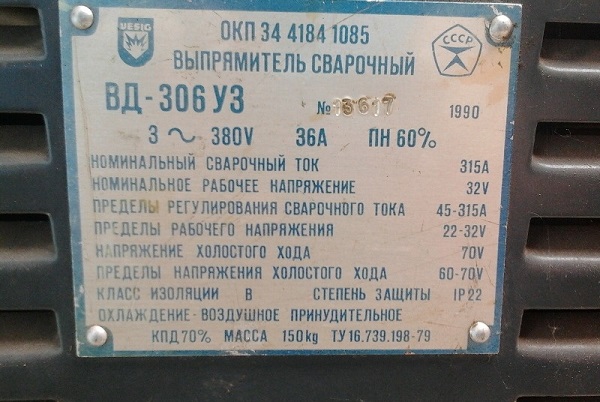
But, as practice shows, this is exactly the default mode of operation that is obtained by any welder due to technological stops (replacement of the electrode or welded parts, movement within the workplace, etc.).
Transformers
The welding transformer unit is a traditional and most widespread type of equipment for contact welding. The basis of its design is to reduce transformer. He is engaged in converting the voltage supplied from the mains into a current suitable for welding.

To change the current in these units, the method of winding displacement relative to each other is most often used.
Distinctive features
A distinctive feature of the transformer welder is that alternating current is applied to the electrode. That is, the conversion is on. voltage only. As a result, the metal spatter increases, which affects the quality of the seam. The efficiency of transformers is around 80%, since most of the energy is wasted on heating the “iron” of the device.
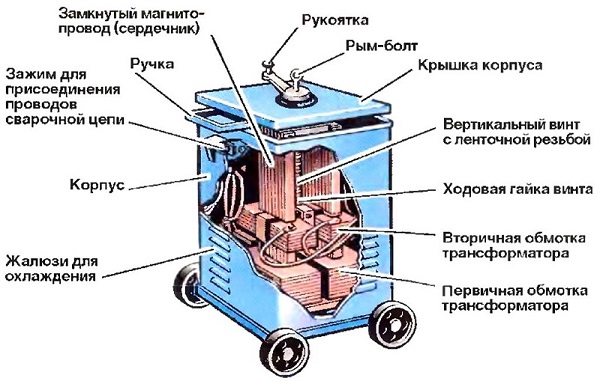
The units are divided into household, generating current up to 200 A, semi-professional and professional, up to 300 A and more than 300 A, respectively.To use the device in domestic conditions, an electric single-phase current of 220 V is used. But professional equipment most often uses a three-phase current with a voltage of 380 V.
Transformers usually work with electrodes from 2 to 5 mm. More accurate information about this can be found in the passport to the device.
Scope of application
Transformer welders are unpretentious devices and are used in almost all areas of human activity where welding compounds of ferrous metals are required. The devices are used for the following purposes:
- connection of metal structures at the construction site;
- laying and repair of pipelines;
- welding of plumbing pipes;
- connection of sheet materials, both in a joint, and with an overlap.
Advantages and disadvantages
The advantages of transformer type devices include the following:
- low cost of the unit, including its maintenance;
- high reliability;
- ease of repair;
- reliability and ease of operation;
- Efficiency up to 80%;
- simplicity of design.
Disadvantages of transformers:
- considerable size and heavy weight - from several tens to one hundred kilograms and above, which complicates its transportation;
- unstable arc;
- metal spraying;
- mediocre suture quality;
- difficulty in igniting the arc;
- sensitivity to voltage drops in the network;
- To perform high-quality welding, an employee needs to have certain qualifications and experience.
Welding rectifiers
These devices are an improvement of transformer welders and are able to provide work with continuous and stable arcthat has a positive effect on the quality of the seam. Because of the simplicity of the design, even inexperienced operators can work with this unit.
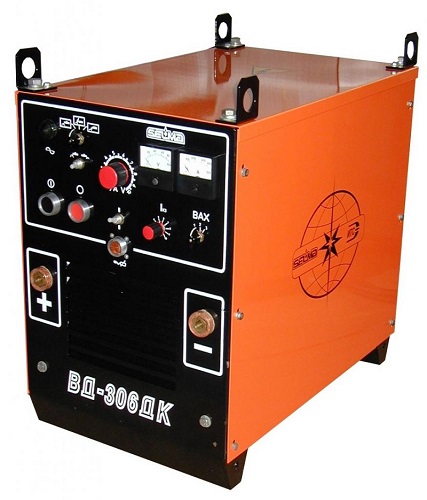
Distinctive features
In the construction of the unit, in addition to the step-down transformer, there is a diode bridge, as well as elements for adjusting the current-voltage characteristics (I – V), protection and starting elements. Thanks to the transformer and the rectifier unit, not only the voltage of the incoming current is reduced, but it is also transformed into a constant one. Due to the supply of direct current to the electrode, metal spatter decreases, the arc behaves more stably than on transformer devices, and the seam, respectively, is of good quality.
Scope of application
DC welding machine is designed for the following purposes.
- Connection by welding of corrosion-resistant metals, alloyed and carbon steels MMA-DC method. Electrodes having a cellulose or basic coating can be used with the apparatus.
- For argon welding all metals, except aluminum and alloys based on it, the method of TIG-DC, that is, non-consumable electrode. This method is available if the rectifier is completed with BUSP-TIG (welding process control unit).
- For sharing with the feeder of an electrode wire, and also the power supply unit. This combination turns an ordinary apparatus into a semi-automatic capable of welding. MAG-DC and MIG-DC methods.
Welding rectifiers are widely used in engineering and shipbuilding, in construction, during the laying of pipelines, as well as in the domestic sphere. Devices can be stationary and mobile, equipped with a chassis.
Advantages and disadvantages
The main advantages of welding rectifiers:
- improved efficiency;
- minimized power losses;
- good seam quality;
- simplicity of design;
- stable arc;
- low noise;
- improved dynamic performance current;
- arc ignition reliability;
- a small amount of spatter is produced during welding;
- the ability to cook stainless steel and non-ferrous metals.
Disadvantages apparatus:
- big weight;
- "Drawdown" of voltage in the power grid;
- sensitivity to voltage drops;
- high price when compared with the transformer apparatus.
Inverters
These types of welding machines are equipment that provides reliable and high-quality connection of metals. Inverters - enough popular units, both among professionals, and among house masters thanks to the small weight, the compact sizes, high quality of welding and reasonable price.
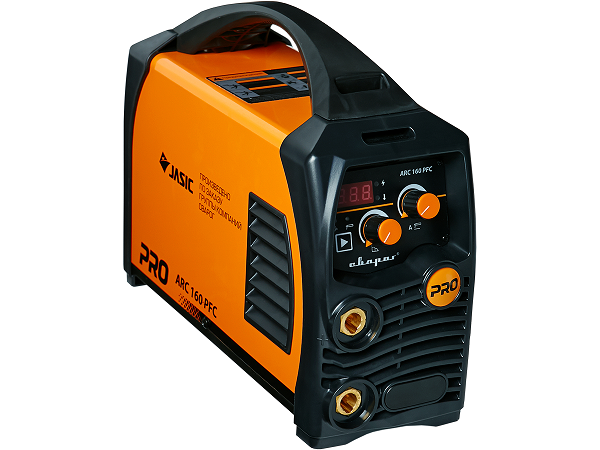
Distinctive features
A distinctive feature of inverters is that the current, starting from the entrance to the device and ending with the output from it, undergoes several transformations:
- alternating current coming from the mains or generator, goes to the primary rectifier, where it is converted to a constant;
- further, the direct current, passing through an inverter unit consisting of a group of transistors, becomes again variable, but already with an increased oscillation frequency (tens of kilohertz);
- high-frequency current falls on a step-down transformer, where simultaneously with a decrease in the voltage, the current strength increases by several times;
- the current reaches the secondary rectifier, which is already installed at the output of the unit, where it is converted again to a constant one, and then it is directed to the electrode.
Thanks to the use of an inverter converter, it becomes possible to reduce the size of the step-down transformer and, accordingly, the dimensions of the apparatus. Also, the inverter has a fairly high efficiency - not less than 90%, and is characterized by high quality welds.
The devices are equipped with thermal protection, protection against surges of the mains voltage, the function of “hot start” and protection against sticking of the electrode.
Scope of application
Welding inverters are used for electric arc welding (MMA) with stick electrodes, as well as TIG, MIG and MAG welding. as part of semi-automatic stations. Such an opportunity arises if you connect to it a wire pulling mechanism (with a control unit), which can be bought in China. But most often inverters are used as portable MMA units at the construction site, during the repair and installation works, for welding wires, as well as in the domestic sphere for the connection of metals.
Often inverters are used. in welding generators. This combined unit can operate in field conditions and on construction sites remote from the power grid. Gasoline welding generator is more affordable than diesel, and can be used for domestic needs, including as an autonomous power plant.
Advantages and disadvantages
Inverters are universal in their use units, used both for butt welding and for overlapping of parts, and have the following positive characteristics:
- increased efficiency (up to 95%);
- compact size and low weight (4-10 kg), allowing you to easily transport the device;
- high quality welding due to the large number of settings;
- electric arc stability;
- can be used as a welder for copper wires;
- Newbies can work with this equipment;
- all types of electrodes can be used with the device;
- PN at inverters reaches 80%.
The disadvantages of inverters, however, are quite noticeable.
- The high price of the unit.
- Expensive repair. Repair of a failed IGBT unit will cost half the cost of a new inverter.
- Sensitivity to dustiness of the room. Dust, settling on the radiators of transistors, significantly reduces heat transfer, as a result of which they overheat.
- At low temperatures, condensate forms on the electronic boards, due to which they can burn out.
Welding semi-automatic
Semiautomatic machines are units that are used mostly by professionals for welding any metals, including dissimilar ones. According to statistics, almost 70% of all welding work in Russia is carried out with the help of semi-automatic machines.
Distinctive features
This type of welding equipment consists of:
- welding unit of transformer or inverter type;
- devices that feed the electrode wire;
- hose burners;
- cylinder with a protective gas.

The welding process takes place using special wireserving as an electrode. The place of the weld pool is injected with protective gas (usually carbon dioxide gas) in order to prevent oxygen from entering it from atmospheric air. The wire feed speed and the gas flow rate in the semiautomatic device can be adjusted to achieve optimum seam quality.
On semiautomatic devices it is possible to work both with gas, and without gas, using a wire with a powder covering.The protective coating at high temperature, evaporating, creates a protective gas envelope for the weld pool.
Scope of application
Semi-automatic welding, being a modern equipment, is ideally suited for its application in large and medium-sized manufacturing, in car-care centers and in home workshops. Using a semiautomatic device, it is possible to cook practically any metals, of any thickness, achieving high quality welding, after which processing of seams for slag removal is practically not required.
The main distinctive feature of semi-automatic devices is the welding of thin sheet metals (from 0.5 mm). Most of these properties of the device are useful when car body repairwhere sometimes you need to make a neat seam without a through-burning metal, since other devices are not capable of it.
Advantages and disadvantages
The advantages of semi-automatic machines are as follows:
- high quality of the seam;
- minimal spatter of metal in the process of the apparatus;
- high performance;
- thanks to the work of the unit with the wire it is possible to do long seams without stopping for tooling replacement;
- compound thin metal sheets;
- compound non-ferrous metals and stainless steel;
- the seams are not covered with slag, so time is not wasted processing them.
Cons of semi-automatic:
- gas equipment is required, and since the gas cylinder has a large mass, it makes it difficult to move all the equipment;
- when working in open air protect the burner from the windwhich blows off the protective gas;
- high price of equipment.
Argon arc welding
The name of this method, as it is not difficult to guess, comes from the gas, which is used as a protective. Argon-arc welding can create structures by interconnecting metals that cannot be joined by other methods.
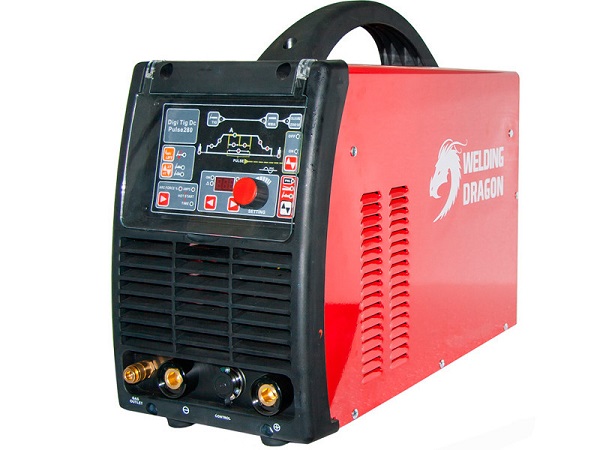
Distinctive features
Argon is heavier than oxygen, so it easily penetrates into the weld pool and protects it from oxidation by oxygen. Welding by this method is carried out using conventional, melting electrodes, and tungstenwhich do not melt in the process of work (TIG method).
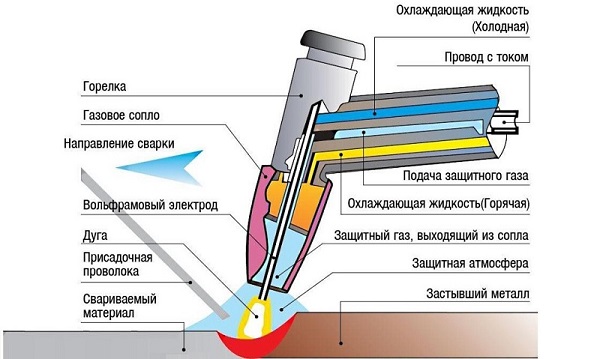
Welding is as follows.
- Argon is fed into the burner and exits through its nozzle.
- An electric arc is ignited between the metal to be connected and the electrode.Since the arc has a high temperature, the edges of the parts to be joined begin to melt.
- In the place where the arc works, the additive is fed, which can be a wire. The tooling can be either automatic or manual.
- The wire, melting, fills the gap between the joined elements, forming a seam.
- During the operation of the unit, the burner is cooled with water through a system of pipes connected to it.
It is worth noting that it is almost impossible to ignite the arc in argon due to the high ionization rate of this gas. To do this, a higher voltage is required. Therefore, for ignition of the arc, use a device called an oscillator that supplies high-voltage and high-frequency voltage to the electrode. This ensures the ionization of the gas in the gap between the electrode and the metal being welded, where the electric arc occurs.
Scope of application
Argon welding method is widely used to connect all types of metals. But in most cases it is used for welding aluminum and stainless steel. at service stations. If it is required to weld a radiator or a tube in an air conditioner, there is no better way than argon-arc welding to find a crack in the gearbox housing.
In addition, the argon apparatus is used for welding duralumin, cast iron, titanium, copper, silumin and other metals, including non-ferrous and alloys based on them. Another argon welding machine used to connect parts of complex shapeFor example, when creating forged products for interiors: fencing of fireplaces, pieces of furniture, chandeliers, gates, etc.
Advantages and disadvantages
The advantages of the argon unit include the following:
- reliable and tight connection;
- due to the low heat of the connected parts thermal deformation of the product does not occur;
- dissimilar metals can be joined;
- Welding materials are performed at high speed.
Disadvantages of argon arc welding:
- complex equipment;
- To work with the equipment requires skilled, experienced professionals.
Spot Welding Machines
The spot welding machine is type of contact devices and quite demanded as a method of combining metals.In this method, metals are connected by one or several points located at a certain distance. From the structure, as well as the size of the point depends on the strength of the connection. The characteristics of the point are affected by: properties of the electrodes, force and time of compression, current parameters, properties of the metal of the parts to be joined.

Distinctive features
Most commonly used for spot welding machines having capacitors in their composition. The latter accumulate energy, and at the time of connecting the electrodes give it away. This forms a welding pulse with a high amperage, so that the parts to be joined are welded at the point of contact of the electrodes.
Electrodes for this device can be of various shapes, as shown in the following photo.
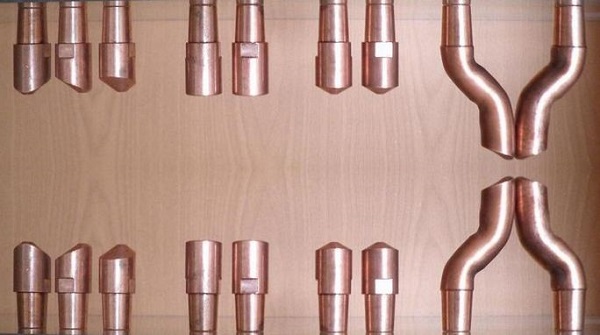
Due to a very short pulse (hundredths or thousandths of a second), the range of exposure to high temperatures is minimized, which makes it possible to combine metals with a thickness of 0.1 mm.
Scope of application
For spot welding, the following applications can be distinguished.
- Manufacture of stamped structures with simultaneous point connection of parts, for example, in the automotive and aircraft industry,when creating a comic technique, as well as other technology, the design of which includes parts of the profile forms.
- Instrument making. In this area, point methods of joining parts are used in the manufacture of miniature-sized assemblies and instrument cases of thin-walled materials.
- Car repair shopsengaged in body repair.
Advantages and disadvantages
The advantages of turned metal welding include:
- high performance (in the production process is fully automated);
- welding electrodes can be installed on robot manipulators, on automatic lines;
- no filler materials are required;
- high quality of welded joints;
- the ability to connect very thin parts;
- high qualification of the operator is not required.
Disadvantages of the method:
- it is impossible to connect dissimilar metals;
- seam leakage;
- the complexity of the design of the compression mechanism, as well as the welding head;
- high price of stationary equipment.
Gas welding
This is an electrodeless method of joining metal products, which is easy to use, does not require a source of electricity and expensive equipment.
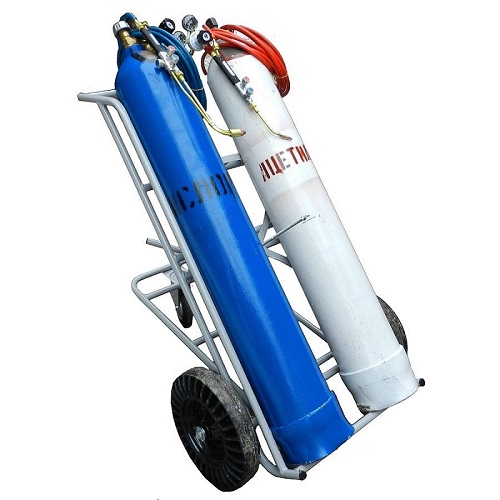
Distinctive features
In gas welding, the connection of metals occurs by melting the edges of the part and filler wire, which are heated by a directed stream of burning gas coming out of the torch. Efficient and stable gas combustion in the burner is provided by creating a mixture of acetylene and oxygen. In addition to using acetylene, hydrogen is often used to increase productivity.
Hydrogen welding machine (electrolysis) is safer in operation and is characterized by the formation of high quality seams. Instead of a gas cylinder, a special unit, called an electrolyzer, is used in which water is decomposed into oxygen and hydrogen. This process is due to the effect of electric current on water. Subsequently, the hydrogen enters through the hose to the burner, and the welding process takes place in the usual way, as when using bottled gas.
Scope of application
Gas welding equipment is used for the following purposes:
- compound metals such as aluminum, silumin, lead, copper, stainless steel, ferrous and other types of metals;
- welding cracks and installing patches on metal products;
- hermetic joining of pipes of small and medium diameters, including thin-walled ones;
- surfacing brass coating on metal parts;
- manufacturing various containers and vessels.
On a note! In addition to the combination of metals, gas torches are used for cutting metals of various thicknesses.
Advantages and disadvantages
Advantages of gas welding:
- expensive equipment is not required;
- availability of consumables;
- energy source is not required;
- adjustment of flame strength and degree of heating of the part is possible.
Disadvantages of the method:
- long heating of the metal in comparison with arc welding;
- wide area of heat exposure;
- the cost of acetylene and oxygen exceeds the cost of electricity, if the same welding works are carried out for comparison, using both methods;
- low speed of work at the connection of thick parts, since there is a significant heat dissipation through the workpiece;
- the method is difficult to automate;
- used gases (acetylene and oxygen) are highly explosive;
- rather bulky equipment, which requires transport to move.
Induction Welding
Induction method of joining metal products called high frequency. According to the principle of operation, the induction equipment differs significantly from the traditional one and is quite relevant, especially in production. The welding process is as follows. First, the part is heated by a high frequency induction current. After heating the workpiece, it is compressed with the help of rollers, as a result of which the edges are welded.

Mostly induction welding equipment is used in industries engaged in release of seam welded pipes.
Advantages of the induction method of combining metals:
- rapid heating of the workpiece and the same rapid welding;
- compound has high quality and durability;
- the seam is smooth, without scratches.
Cons of the method:
- difficult to maintain the gap between the workpiece and the inductor;
- high power consumption;
- after welding it is difficult to clean the inner seam.
Plasma welding
Apparatuses for plasma brazing, cutting and welding of metals are quite widespread, due to their ability to perform the above tasks in a short time and with high efficiency.
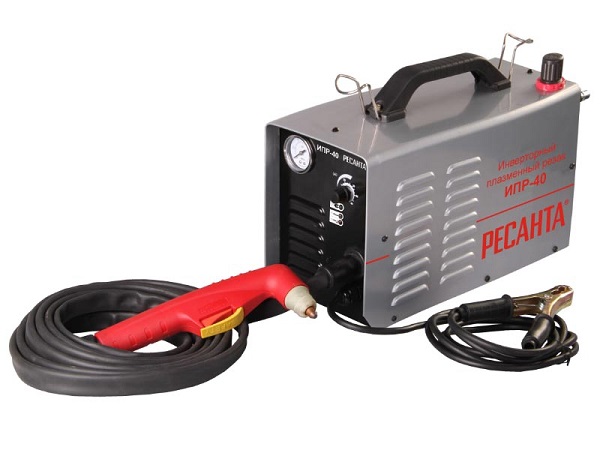
Distinctive features
Plasma welding is similar to argon, but the whole process takes place using plasma flow. The basis of the plasma is an ionized gas, which is sent in the right direction.
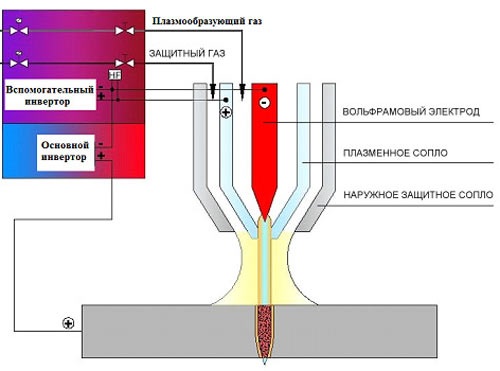
In order to transform a conventional arc into a plasma arc, that is, to increase its temperature and power, the plasma-forming gas is forcedly blown in, after which the arc is compressed. To compress the arc, on the devices use the device called a plasma torch. Its main task is to reduce the cross section of the arc, which increases its power and energy. During operation of the unit, the plasma torch walls are subjected to water cooling, since the temperature of the plasma that forms in it reaches 30,000 ° C, while the usual arc has a temperature of only 5,000 ° C.
Also during the arc compression, plasma-forming gas is injected into its area, where it, when heated, ionizes and expands 50-100 times. Further, this gas leaves the nozzle at high speed, as a result of which the combination of thermal and kinetic energy forms a powerful plasma flow.
Scope of application
Plasma welding is widely used in engineering, automotive, aircraft and rocket, where it is required high accuracy and quality of connection parts from various metals. Also, this type of unit is used in the construction of gas pipelines, heating networks, high pressure oil pipelines, power plants and other facilities.
Microplasma welding is used in production, where there is a need to join a thin sheet metal, for example, in instrument making.
Plasma aggregates can combine metals with a thickness of 0.025 mm. The seam at the same time has a minimum width, and a small zone of thermal influence eliminates the deformation of the product.
In addition, the plasma with success cuts any metals. Therefore, these devices are widely used for plasma cutting with high speed.
Advantages and disadvantages
The advantages of the plasma welding machine include:
- small size of the arc, which allows precise work;
- high plasma temperature accelerates the workflow;
- can work with any metals and non-metallic materials (cutting of concrete, glass, ceramic tiles, etc.), which can not be done by any welding unit;
- Only glasses can be used to protect your eyes;
- arc stability;
- very thick parts can be cooked;
- ease of use;
- compact and light weight.
The disadvantages of the units:
- the presence of ultraviolet radiation;
- air ionization positively charged ions, which does not, for example, laser method of welding;
- harmful metal vapors enter the surrounding air.
In addition, plasma welding machines have high cost (from 100 000 rub.), and not all mid-level enterprises can afford to purchase this equipment. But the plasma cutter has a more reasonable price (from 20,000 rubles) and is available for private, small workshops.

/rating_off.png)











